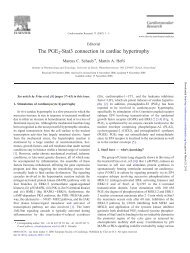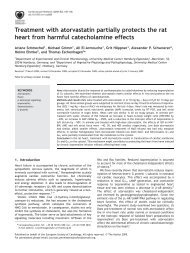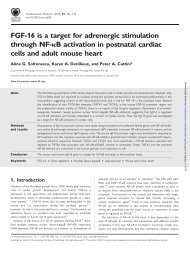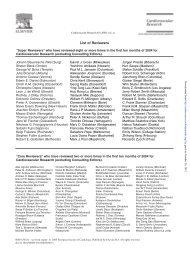Cilostazol inhibits cytokine-induced nuclear factor-kB activation via ...
Cilostazol inhibits cytokine-induced nuclear factor-kB activation via ...
Cilostazol inhibits cytokine-induced nuclear factor-kB activation via ...
Create successful ePaper yourself
Turn your PDF publications into a flip-book with our unique Google optimized e-Paper software.
Page 4 of 7<br />
3.2 <strong>Cilostazol</strong> <strong>inhibits</strong> NF-<strong>kB</strong> <strong>activation</strong> and <strong>inhibits</strong><br />
vascular cell adhesion molecule-1, E-selectin,<br />
intercellular adhesion molecule-1, monocyte<br />
chemoattractant protein-1, and PECAM-1<br />
mRNA induction<br />
We initially examined the effect of incubation of cilostazol<br />
with TNFa for 2 h on NF-<strong>kB</strong> <strong>activation</strong> in SVEC4 cells. TNFa<br />
<strong>induced</strong> a 7-fold increase in NF-<strong>kB</strong>-mediated reporter gene<br />
expression. <strong>Cilostazol</strong> dose-dependently suppressed TNFaelicited<br />
<strong>activation</strong> of NF-<strong>kB</strong> (Figure 2A). We then examined<br />
the effect of siRNA specific for AMPKa1 on cilostazol<strong>induced</strong><br />
NF-<strong>kB</strong> inhibition, which was partially but significantly<br />
attenuated in AMPKa1 siRNA-transfected cells,<br />
compared with cells transfected with control siRNA<br />
(Figure 2A).<br />
We also measured p50 and p65 in <strong>nuclear</strong> extracts from<br />
untreated HUVEC and from those treated with TNFa in the<br />
presence (30 or 100 mM) and absence of cilostazol. Both<br />
p50 and p65 markedly increased 30 min after stimulation<br />
with TNFa, from very low levels. This increase was dosedependently<br />
inhibited by cilostazol (Figure 2B).<br />
Incubation for 24 h with TNFa substantially <strong>induced</strong> the<br />
gene expression of VCAM-1, E-selectin, ICAM-1, and MCP-1.<br />
Induction of TNFa-<strong>induced</strong> gene expression was markedly<br />
suppressed by co-treatment with an NF-<strong>kB</strong> inhibitor,<br />
BAY11-7082, which is known selectively and irreversibly to<br />
inhibit <strong>cytokine</strong>-<strong>induced</strong> I<strong>kB</strong> phosphorylation, 20 suggesting<br />
that induction of these genes may be NF-<strong>kB</strong>-dependent<br />
(data not shown). <strong>Cilostazol</strong> significantly inhibited TNFa<strong>induced</strong><br />
gene expression (Figure 2C). We also examined the<br />
effect of cilostazol on TNFa-<strong>induced</strong> gene expression of<br />
PECAM-1 and P-selectin, adhesion molecules relevant in<br />
platelet–endothelium interaction. PECAM-1 mRNA was substantially<br />
<strong>induced</strong> by TNFa, which was clearly inhibited by<br />
cilostazol. Although P-selectin mRNA was modestly <strong>induced</strong><br />
by TNFa, cilostazol did not affect the induction of P-selectin<br />
gene expression (Figure 2C).<br />
3.3 <strong>Cilostazol</strong> <strong>inhibits</strong> adhesion of monocytic cells<br />
<strong>via</strong> suppressing NF-<strong>kB</strong> <strong>activation</strong><br />
Treating HUVEC with TNFa for 4 h significantly increased<br />
THP-1 cell adhesion. Pretreatment with cilostazol inhibited<br />
the TNFa-<strong>induced</strong> adhesion of THP-1 cell to HUVEC in a<br />
dose-dependent manner (Figure 3A). An NF-<strong>kB</strong> inhibitor<br />
BAY11-7082 markedly inhibited TNFa-<strong>induced</strong> THP-1 cell<br />
adhesion to HUVEC (Figure 3A). We then examined the<br />
effect of siRNA specific for AMPKa1 on cilostazol-<strong>induced</strong><br />
inhibition of THP-1 cell adhesion, which was significantly<br />
attenuated in AMPKa1 siRNA-transfected cells, compared<br />
with cells transfected with control siRNA (Figure 3B).<br />
3.3 TNFa stimulates I<strong>kB</strong> phosphorylation by<br />
inducing I<strong>kB</strong> kinase activity, while cilostazol<br />
<strong>inhibits</strong> TNFa-<strong>induced</strong> I<strong>kB</strong> kinase activity and<br />
I<strong>kB</strong> phosphorylation<br />
We first determined whether TNFa-<strong>induced</strong> NF-<strong>kB</strong> <strong>activation</strong><br />
might occur through phosphorylation and subsequent degradation<br />
of I<strong>kB</strong>. To determine whether TNFa might induce I<strong>kB</strong>a<br />
phosphorylation in HUVEC, western blot analysis using the<br />
antiphospho-Ser32 of I<strong>kB</strong>a antibody was performed. TNFa<br />
was observed to induce I<strong>kB</strong> phosphorylation within 15 min,<br />
Y. Hattori et al.<br />
Figure 2 (A) <strong>Cilostazol</strong> <strong>inhibits</strong> tumour necrosis <strong>factor</strong> alpha (TNFa)-<strong>induced</strong><br />
<strong>nuclear</strong> <strong>factor</strong> (NF)-<strong>kB</strong>-<strong>activation</strong> in SVEC4 cells. <strong>Cilostazol</strong> dose-dependently<br />
suppressed TNFa-activated NF-<strong>kB</strong>-dependent transcriptional activity, which<br />
was significantly attenuated in cells transfected with AMP-activated protein<br />
kinase (AMPK) siRNA (10 nM). Closed (control scrambled siRNA) and open<br />
squares (AMPK siRNA) represent the results in the absence of TNFa,<br />
whereas closed (control scrambled siRNA) and open circles (AMPK siRNA) represent<br />
the results in the presence of TNFa (n ¼ 6). Inset: Cells were transfected<br />
with AMPKa1 or control siRNA for 48 h, after which the protein<br />
levels of AMPKa1 were determined by western blot analysis. Results represent<br />
the means + SEM (n ¼ 4). **P , 0.01 vs. NF-<strong>kB</strong> activity in the<br />
absence of cilostazol, # P , 0.05, ## P , 0.01 vs. NF-<strong>kB</strong> activity in the presence<br />
of cilostazol. (B) Human umbilical vein endothelial cells (HUVEC) were stimulated<br />
with TNFa in the presence or absence of cilostazol (Cil30: 30 mM,<br />
Cil100: 100 mM) for 30 min. NF-<strong>kB</strong> p65 or p50 subunits were quantified<br />
within <strong>nuclear</strong> extracts using a transcription <strong>factor</strong> assay kit. Results represent<br />
the means + SEM (n ¼ 4). *P , 0.05, **P , 0.01. (C) Effects of cilostazol<br />
on TNFa-<strong>induced</strong> vascular cell adhesion molecule-1 (VCAM-1), E-selectin,<br />
intercellular adhesion molecule-1 (ICAM-1), monocyte chemoattractant<br />
protein-1 (MCP-1), PECAM-1, and P-selectin mRNA expression in HUVEC. <strong>Cilostazol</strong><br />
(30 mM) significantly inhibited VCAM-1, E-selectin, ICAM-1, MCP-1, and<br />
PECAM-1 mRNA levels. White bars: control, grey bars: control treated with<br />
cilostazol, black bars: TNFa, hatched bars: TNFa treated with cilostazol.<br />
Data represent the means + SEM (n ¼ 4) and are expressed as a ratio of<br />
GAPDH. **P , 0.01 compared with the value of TNFa.<br />
and decreased levels of phospho-I<strong>kB</strong>a were observed at<br />
60 min (Figure 4A). The blot was then re-probed with<br />
anti-I<strong>kB</strong> antibody, producing evidence of significant degradation<br />
within 15–30 min. After this, I<strong>kB</strong> synthesis was<br />
Downloaded from<br />
http://cardiovascres.oxfordjournals.org/ by guest on July 2, 2013









